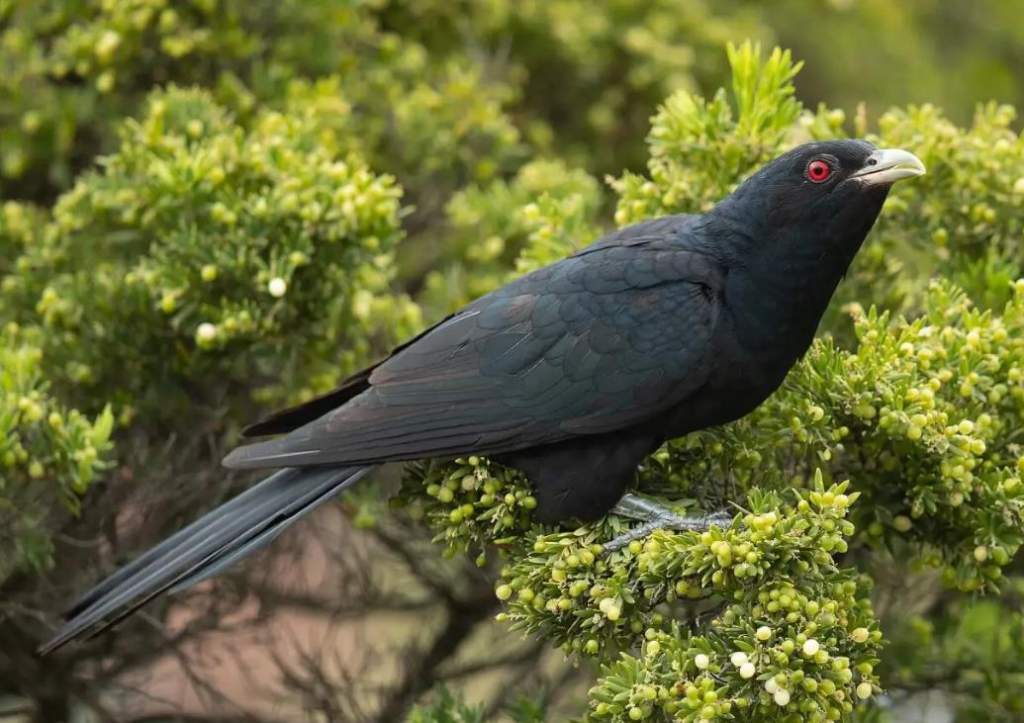Family: The Asian koel (Eudynamys scolopaceus) is a member of the cuckoo family Cuculiformes in the genus Eudynamys.
Habitat: Asian Koel is normally called common koel in Australia, but it appears to migrate in an odd crisscross pattern throughout the country. The smaller race that breeds across northern Australia each summer migrates northeast each year to winter in New Guinea. Crossing it, the larger form that nests down the eastern seaboard moves to and for in the other direction to winter through Indonesia to perhaps the Philippines. Both races are present and nesting in Australia at the same time, arriving in September–October, and live in riverside scrubs, monsoon thickets, rainforests, and dense pockets of eucalypts.
Vocalizations: Common koel vocalizations are famous throughout the world. It has a long-drawn, upslurred whistled coo-ee repeated monotonously in an advertisement by the male. In courtship or excitement, a whirling whistled crescendo by a male is often introduced antiphonally by a female with about four loud shrieking whistles. Also, gurgles, chuckles, and croaks are given, especially by females, when pursued by courting males. Their shrill coo-ee calls can be heard mainly in the mornings and evenings and often at night.
Behavior: Common koel keep to the seclusion of leafy trees and shrubs and are often hard to observe. The females are silent and retiring, but the males are less secretive and easier to see, particularly when there is a female nearby or when they are in more open habitats around towns. Koels are usually found singly, in pairs, or in small courting groups, generally consisting of one female and two or three males. At times, they can be seen in fairly large groups, feeding on fruiting trees in association with flocks of other species. On rare occasions, they have been observed stealing small birds’ eggs. Their parasitism rates are approximately 35% to 10.8% for long-tailed shrikes, common mynas, and house crows, respectively. Koel tended to favor host nests that were closer to fruit trees and at lower elevations. Moreover, koels have been observed to parasitize the European magpie, the black-headed oriole, and the black drongo on occasion in the Indian Subcontinent.
Diet: As an omnivore, the Asian koel eats a wide range of insects, caterpillars, eggs, and small vertebrates. Although adult koels are mainly fruit-eaters, the nestlings accept insects and other food from their foster parents. They consume Cascabela thevetia fruits, which are poisonous to animals. On occasion, they will protect fruit trees where they feed and drive other frugivores away. They have been identified as having particular significance in the Indian sandalwood tree’s (Santalum album) dissemination.
Identification: The male cuckoo is all dark, glossy black with a blue-green tinge. Eyes are dark red to vermilion. Bill blue-grey to cream-grey with a lighter tip, or at times greenish. Feet mid- to dark grey or grey-brown. FEMALE: Head glossy black with a blue-green tinge. The rest of the upper parts were brown-tinged with bronze-green, feathers indistinctly barred and tipped white, and upper tail coverts, tail, and flight feathers crossed with white bars. The chin and sides of the face are dull black; a pale buff line runs from the base of the bill to the throat. The center of the throat and neck are washed with cinnamon to buff and often mottled black. The rest of the underparts and underwing coverts are off-white to pale buff barred dusky brown. Their eyes are vibrant red. The bill is cream-grey. The feet are grey-brown. The immature koel differs on whether young birds resemble adults’ sex for sex, or whether they resemble females only. The eyes are dark olive-brown; the bill is deep buff; and the feet and claws are blue-grey.

Nesting: The nesting and breeding occur mainly in September-March, depending on rain and the breeding of hosts. Parasitic. The Common Koel does not build a nest but lays its eggs in the nests of other species, including blue-faced honeyeaters, red wattlebirds, friarbirds, figbirds, orioles, and magpie-larks. Female koel lay one egg in each nest, appear to choose foster parents whose eggs have a similar size, shape, and color to their own, and time egg-laying to occur just after the host birds. A pair of Magpie-larks have been recorded raising three successive koels in one breeding season; a pair of breeding koels may occupy a territory covering those of up to five pairs of Magpie-larks.
Eggs and Incubation: Typically, koels will only lay one or two eggs in a single nest, however, certain host nests have been known to produce up to seven or eleven eggs. The eggs are smooth, pink, or buff, usually with a slight sheen, sprinkled with spots, dots, and sometimes short wavy streaks of dull purple-red, with underlying markings of purple-grey; they are oval, about 34 x 24 mm. After 13 or 14 days, the koel chicks hatch and are able to devour all of the food that the foster parents bring. The baby koel ejects or starves the other nestlings from the nest. The young fled in 24 to 28 days.
Distribution: The Asian koel is a forest and agricultural bird. It is mostly a resident breeder in tropical southern Asia, ranging from southern China and the Greater Sundas to Iran, Pakistan, India, Bangladesh, and Sri Lanka. The breeding summer migrant crosses coastal and subcoastal northern and eastern Australia, occasionally straggling to northeastern Victoria and even New Zealand. Mainly in monsoon forests, rainforests, and denser vegetation of river courses; also open forests, denser woodlands, paperbark swamps, and mangroves. Elsewhere, India and southeastern Asia go to the Solomon Islands.
Alternative Names: This beautiful long-tail cukcoo is also known as Cooee-bird, Rainbird, Asian Koel, and Indian Koel.
Size: The common koel size is about 390-460 mm in length and weighs 190–327 g (6.7–11.5 oz).
Races: There are about 15 or more races, but only two are found in Australia.
Lifespan: These resilient birds survived up to 14 years in captivity, even being fed just cooked rice.







